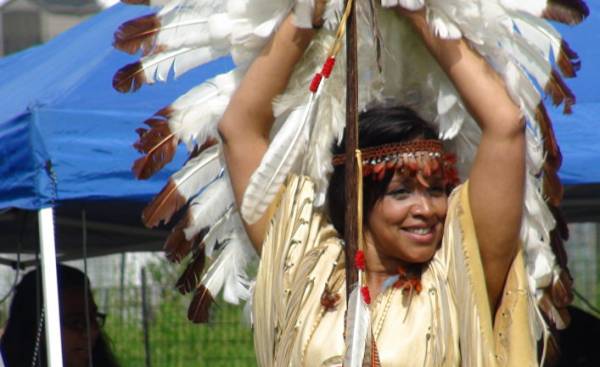
In Colombia there are two words that represent the inequality of the sexes Indian woman. They are subjected to discrimination based on sex, ethnic and social grounds, because in most cases, poor. From birth they learn that their role is to run the household and raise children. They not only perceive childhood machismo as a given, but are the main victims of violence against women in this Latin American country. Abuse inside and outside the community, forced prostitution, displacement and murder for one lasting more than half a century of war, eviction from ancestral territories due to the occurrence of legal and illegal mining. On top of that their suffering is not visible to anyone. The lack of census data and state aid leaves in the darkness of the tropical rainforests — where they live — the living conditions of these women.
One of the worst secrets of the lives of Indian women became public in 2007. Two girls from the tribe of ember, one of the 80 ethnic communities of Colombia, died as a result of female genital mutilation on the genitals. At the moment rural midwives are unable to keep this secret, and Colombia became the first and only country in the Americas to recognize the existence of this practice. Women are acting as doctors in their villages have sacred knowledge that no one dares to challenge, that the clitoris can grow to the same size as the penis, and therefore I think his physical deformity. “Therefore, they believe that you need to remove it at birth,” explains Patricia Tobon (Patricia Tobón), Indian amber and a lawyer by profession, who heads the group of lawyers defending the rights of its people, especially women.
Around the world
250 thousand Indians of the emberá live in Colombia, but they are found in Panama and in Ecuador. They settled in different areas of the country, very often in a remote jungle. To their habitats, where it is especially hard tolerated the hardships of war, do not reach any roads or hand the ministries of health and education, as well as government agencies, whose job it is to combat the practice, is equated to the deliberate infliction of harm to health and the violation of fundamental women’s rights, all women’s sexual and reproductive. “We work inside communities of ember, promoting awareness of Indian and Indian authorities,” said the lawyer, one of two women with higher education in his native village. In 2012, they managed to make it to the tribal elders recognized that female genital mutilation genitals are not part of their culture. “Only the Colombian authorities keep silence.”
Patricia Tobon did not give up and continued to fight, until I got to this question were included as objectives in the development plan of Colombia. “With 2014 to combat this problem have not been allocated any resources,” she says. Their group requires campaigns and real help with the intercultural principle. Indian women, in the best case, bilinguals, but need to social employees spoke to them in their language and could understand that they allow you to mutilate their daughters because they don’t know that it’s bad for them.
To achieve its goals human rights activists immediately faced with a huge obstacle. In Colombia, there are no statistics on how many Indian women living in the country, even more difficult to understand, how many girls ember is born and how many die from female genital mutilation. The last census conducted in the country in 2005, national statistical office. At that time, the number of native American communities has reached 1.3 million people, of which nearly 680 thousand, that is, 49.5 percent, were women. This is 3% of the total female population of Colombia. The national indigenous organization, which includes 80% of all Indian associations, cites the parallel of the census, three million, almost two times more than the official version.
The girls of the Embera, as well as other Colombian Indians, the lowest in the country indicators of school attendance. “Education is the most important aspect, because it has extremely limited access,” says Ana Teresa Vergara (Ana Teresa Vergara), from the tribe of ember, an employee of the Council for the advancement of women in indigenous Organizations of the Department of Antioquia. “We give life to our children, but it’s a time when our mind, and our decisions should be honored by the organization.” Her work lies in the fact that women not only participated in the government of Amerindian communities, but to IZH voices heard.
Machismo and the lack of economic resources condemn Indian women on life between the kitchen and the yard of his house. In 2014, according to the latest census, the rural population, just over 115 thousand girls over 5 years of age attended school from almost 360 thousand school age. From the bottom of the majority, 61 thousand 300 have received only primary education. Only 2726 reached the University. Thus, Indian and African unemployed women in rural areas are the most vulnerable part of the population in a country where, according to the international cancam, such as the Gini coefficient of the world Bank, the highest level of inequality.
“To change the behavior of Indian women is simple,” explains Vergara. We’re trying to push them to think about what 500 years ago in Latin America women have equal rights with men were the leaders”. Now they want to return to this state of Affairs. And, as before, with men. “If they are sources of violence and restrictions, they should participate in the process of understanding this,” she said. The first calendar date is marked on this path, 2030, when female genital mutilation genitals should be eradicated worldwide, according to the Millennium development Goals of the UN. By this time, according to activists, the Colombian Indian women, including women of the Embera, not only know their rights and will fight for them, but will cease to be the most vulnerable in Colombia. “We are still only at the beginning of the way,” they admit.
Invisible work
90% of Colombian endin devote nine hours a day on unpaid work around the house, which amounted to 120 billion pesos annually, which are not got of GDP. No sector in the country has such a weight in the economy.
A study conducted by the national statistical office in 2007-2010 revealed that the average workload, paid and not, is for women and 72.4 hours a week of 61.6 for men. In addition to the 14% difference in the number of hours the authors note that a Columbine produce double and triple the norm in the day, and that their housework is always in the shadow.







